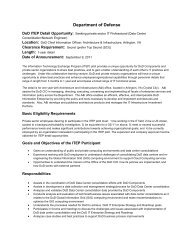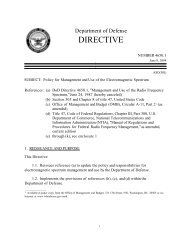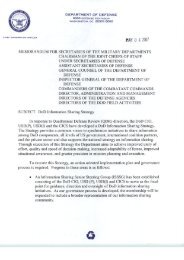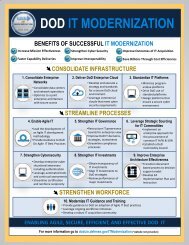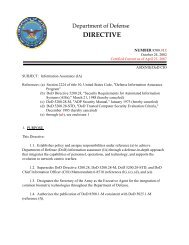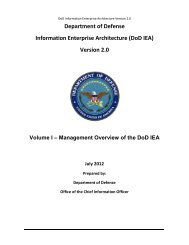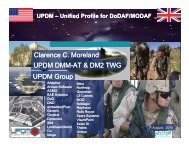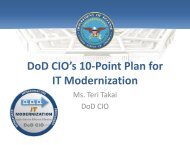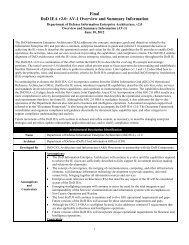DoD Architecture Framework Version 1.5 - Chief Information Officer
DoD Architecture Framework Version 1.5 - Chief Information Officer
DoD Architecture Framework Version 1.5 - Chief Information Officer
Create successful ePaper yourself
Turn your PDF publications into a flip-book with our unique Google optimized e-Paper software.
prepare the way for more efficient and flexible use and reuse of architecture data, enabling<br />
broader utility for decision makers and process 3 owners.<br />
The <strong>DoD</strong>AF is a three-volume set that inclusively covers the concept of the architecture<br />
framework, development of architecture descriptions, and management of architecture data.<br />
• Volume I introduces the <strong>DoD</strong>AF framework and addresses the development,<br />
use, governance, and maintenance of architecture data.<br />
• Volume II outlines the essential aspects of architecture development and<br />
applies the net-centric concepts to the <strong>DoD</strong>AF products.<br />
• Volume III introduces the architecture data management strategy and<br />
describes the pre-release CADM v<strong>1.5</strong>, which includes the data elements and<br />
business rules for the relationships that enable consistent data representation<br />
across architectures.<br />
An Online <strong>DoD</strong>AF Journal, hosted on the <strong>DoD</strong> <strong>Architecture</strong> Registry System (DARS) website<br />
(https://dars1.army.mil/IER/index.jsp), replaces the <strong>DoD</strong>AF v1.0 Desk Book and is designed to<br />
capture development best practices, architecture analytical techniques, and showcase exemplar<br />
architectures.<br />
The <strong>DoD</strong>AF will continue to evolve (see Figure ES-1, Evolution of the <strong>DoD</strong>AF) to meet the<br />
growing needs of decision makers in a Net-Centric Environment (NCE). Going forward,<br />
architectures will need to capture the development of a new generation of net-centric capabilities<br />
stemming from operational insights gained in Afghanistan and Iraq. As the maturation of the<br />
Global <strong>Information</strong> Grid (GIG) continues through GIG Capability Increments (an incremental<br />
time frame approach to the delivery of GIG-enabling capabilities), architectures will be a factor<br />
in evaluating increment investments, development, and performance at the mission portfolio<br />
levels. As the <strong>DoD</strong> increases its use of architecture data for decision-making processes,<br />
architects will need to understand how to aggregate the data for presentation purposes at the<br />
enterprise level. The <strong>DoD</strong>AF plays a critical role in the development of architectures and will<br />
continue to improve its support for the increasing uses of architecture data.<br />
3 CJCS Instruction 3170.01E, Joint Capabilities Integration and Development System (JCIDS); <strong>DoD</strong> Directive 7045.14, Planning,<br />
Programming, Budgeting, and Execution (PPBE); <strong>DoD</strong> Directive 5000.1, The Defense Acquisition System (DAS); <strong>DoD</strong> Directive 8115.01,<br />
<strong>Information</strong> Technology Portfolio Management (PfM)<br />
ES-2




